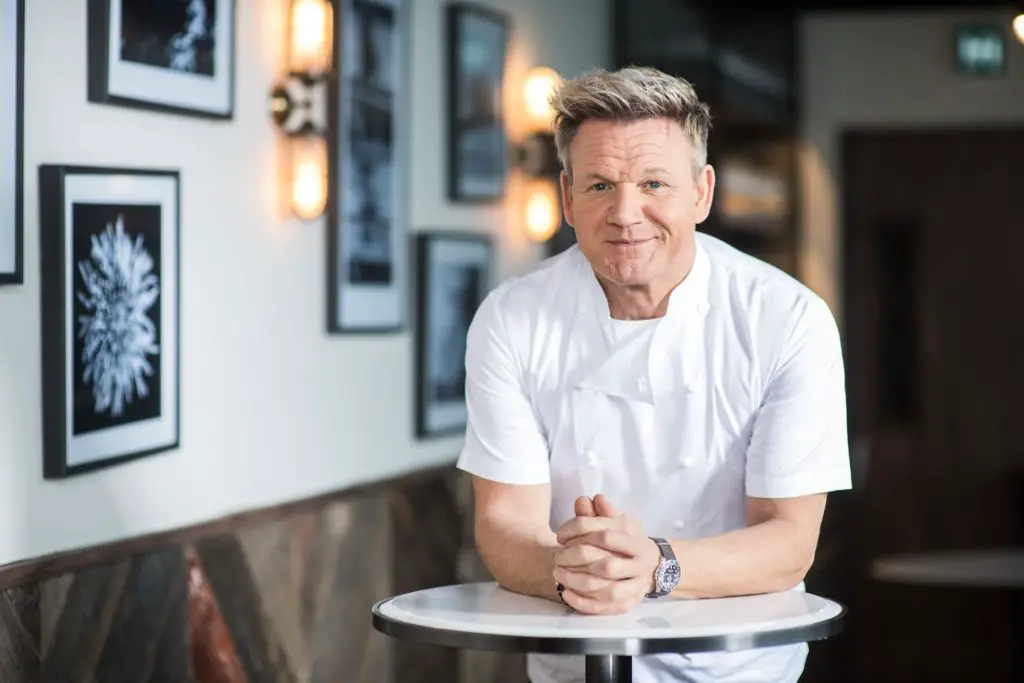Gordon Ramsay, a titan in the culinary world, is renowned not just for his fiery temperament on television but also for his unparalleled expertise in the kitchen. His career, marked by reviving struggling restaurants and pinpointing their deficiencies, has seen him taste and critique a vast array of dishes, from the traditional French bouillabaisse to the avant-garde blancmange, the chic quiche and the health-centric quinoa. His forthrightness in evaluating dishes, whether they’re from seasoned chefs or cooking novices, is both feared and respected.

In an enlightening interview with the Daily Mail, Ramsay divulged three pivotal rules he employs to judge a restaurant’s worth. One particularly striking rule is his skepticism towards eateries that excessively boast about their offerings. Claims of being the “world’s best” or “infamous” often ring hollow to Ramsay, indicative more of marketing ploys than culinary excellence.
Ramsay’s stance is clear: such grandiose claims should be met with caution and a critical eye. The authenticity of these self-proclaimed accolades deserves scrutiny. After all, true culinary mastery doesn’t need overstated labels.
The “Bin End” List: A Hidden Gem in Wine Selection
Gordon Ramsay also imparts invaluable wisdom on wine selection. His insider tip revolves around a lesser-known gem: the “bin end” list. This section of the wine menu is often overlooked but holds the potential for extraordinary finds.
The “bin end” list includes bottles that haven’t sold particularly well or might have minor imperfections, like slightly damaged labels. These factors do not affect the quality of the wine itself, making them hidden treasures waiting to be discovered.
Opting for a wine from this list is not only cost-effective but can also offer a unique drinking experience. These wines are often from batches that are nearly finished, making your choice potentially unique and rare.

Benefits of the “Bin End” Selection
One of the primary advantages of choosing from the “bin end” list is the reduced price. These wines are typically discounted to move stock, providing customers with high-quality options at more affordable rates.
The “bin end” list can include wines that you might not typically choose, offering a chance to explore different flavors and vintages that you might not otherwise encounter.
Tips for Choosing from the “Bin End” List
Don’t hesitate to ask the sommelier or server for recommendations from the “bin end” list. Their expertise can guide you to a wine that complements your meal and suits your taste preferences.
Think about the dishes you have ordered and seek wines that will complement the flavors. A good pairing can enhance both the meal and the wine.
The “bin end” list is an excellent opportunity to try something new. Be open to different types and regions of wine, as this could lead to discovering a new favorite.
Gordon Ramsay also advises on how to approach wine budgeting in restaurants smartly. He suggests asking for the best bottle under $30. This approach encourages setting a budget, which can help in making a wise choice without feeling overwhelmed by the extensive options and prices. A price cap of $30 is reasonable for discovering a quality wine, as many hidden gems are available within this range. It’s a practical way of enjoying premium wines without overspending.
The Illusion of Specials: A Cautionary Tale
Gordon Ramsay, with his extensive experience in the culinary industry, brings to light a crucial aspect of dining out: the reality behind the restaurant’s specials board. His advice is to approach these with a healthy dose of skepticism. In his view, true specials should embody the essence of exclusivity and transience. They are meant to showcase the chef’s creativity, featuring seasonal ingredients or experimental dishes that offer a unique experience distinct from the regular menu.
However, Ramsay notes that, more often than not, the reality diverges from this ideal. A menu that lists an extensive array of “special” dishes can actually be misleading. Their claimed rarity and uniqueness are frequently overstated. In fact, these dishes can be a strategic move to upsell standard menu items at higher prices. This practice not only misleads the customer but also diminishes the genuine excitement and allure that specials are supposed to offer.
Ramsay’s Effective Tactic

Ramsay’s skepticism is further fueled by common practices he has observed in numerous establishments. He specifically mentions the recurring phenomenon of the “soup of the day.” This seemingly innocuous offering is often a litmus test for him. He suggests a simple yet effective tactic: ask about the previous day’s soup. If the response reveals that the same soup has been served consecutively, it’s a clear indicator of a lack of creativity and variety in the kitchen. This routine offering, masquerading as something special, is a red flag about the restaurant’s approach to cooking and menu planning.
This advice from Ramsay is not just about avoiding potential disappointments but also about encouraging diners to seek authenticity in their culinary experiences. It’s a call to be discerning and inquisitive, to look beyond the surface and question what’s presented. This mindset not only enhances the dining experience but also fosters a deeper appreciation for restaurants that genuinely strive to offer something unique and exciting.
Reserving for Three: A Strategy for Quicker Seating
Gordon Ramsay, known for his sharp insights into the restaurant industry, shares a simple yet effective strategy for those looking to secure a table swiftly, especially when planning a special night out like a romantic dinner. His advice: make a reservation for three instead of two. This suggestion might seem unconventional at first, but it’s grounded in a keen understanding of restaurant dynamics.
The Logic Behind Larger Party Reservations
The rationale behind this strategy is rooted in the typical seating logistics of restaurants. Establishments often prioritize larger parties as they represent higher potential revenue. By reserving a table for three, a couple can create the impression of being a larger party, which often leads to quicker seating. This is particularly useful during busy dining hours or at popular restaurants where securing a table for two might involve a longer wait.
This tip is a clever workaround for the common frustration of long wait times, especially on special occasions or at high-demand dining spots. It reflects Ramsay’s deeper understanding of the operational aspects of restaurants, offering a practical solution to a common problem faced by diners.
Navigating Dining Etiquette
While this tactic can be highly effective, it’s important to use it judiciously and consider the potential implications. Some might worry about the ethical aspect of making a reservation for an extra person who won’t show up. To address this, be transparent with the restaurant staff upon arrival or, if comfortable, share that the third person might join later or have had to cancel at the last minute. This maintains honesty in your dealings with the restaurant while still benefiting from the strategy.
Gordon Ramsay’s insights like this one are a testament to his extensive experience in the culinary field. His tips go beyond mere food recommendations, delving into practical strategies that enhance the overall dining experience. From identifying quality beyond hype and making wise wine selections to understanding the intricacies of specials, Ramsay’s advice is designed to ensure a fulfilling and enjoyable gastronomic journey. By adopting these insights, diners can navigate the culinary landscape with greater savvy and enjoyment, turning an ordinary meal into a memorable dining adventure.
Tips for a Memorable Dining Experience
Beyond what to avoid, Ramsay offers guidance on enhancing your dining experience. Here’s a comprehensive list of tips to consider:
1. The Art of Menu Reading: Deciphering Quality
Understanding a menu is akin to reading a story; it reveals much about a restaurant’s quality and culinary philosophy. Gordon Ramsay emphasizes the importance of being discerning when perusing a menu. Look for signs of freshness and seasonality in the offerings. A menu that changes with the seasons suggests a kitchen that values fresh ingredients. Additionally, be wary of menus that are overly extensive. A smaller, well-curated selection often indicates a higher quality of preparation and attention to detail.
2. The Role of Presentation in Gastronomy
Gordon Ramsay places significant emphasis on the role of presentation in enhancing the dining experience. The visual appeal of a dish is not just about aesthetics; it is a testament to the care and precision that goes into its preparation. A well-presented plate demonstrates a chef’s attention to detail, showcasing a balance of colors, textures, and arrangement. The way a dish is presented can often speak volumes about its quality and flavor. It’s an integral part of the culinary experience, setting the stage for the sensory pleasures that follow. As Ramsay suggests, a dish’s presentation is a key factor in building anticipation and enhancing the overall enjoyment of the meal.
3. Understanding the Chef’s Background
Gordon Ramsay underlines the importance of understanding a chef’s background as a window into the dining experience you can expect. Delving into the chef’s training, previous work, and culinary influences sheds light on their cooking style and expertise. A chef’s journey, marked by diverse experiences and influences, often translates into a menu rich in unique flavors and innovative techniques. Ramsay encourages diners to appreciate this aspect, as it can significantly enrich the understanding and enjoyment of the meal, adding a layer of depth and connection to the food.
4. Sustainable and Ethical Eating
In the realm of modern gastronomy, sustainability, and ethical eating have taken center stage, and Gordon Ramsay is a vocal advocate for these principles. He advises diners to pay attention to a restaurant’s sourcing practices, emphasizing the importance of choosing establishments that prioritize local and sustainable ingredients. This approach not only supports local producers and minimizes environmental impact but also often results in fresher, more flavorful dishes. By choosing to dine at places that value sustainability, customers contribute to a more responsible and environmentally conscious food industry.
5. The Importance of Pairing Food and Drink
A great meal is often complemented by the right beverage. Understanding the art of pairing can significantly elevate your dining experience. Whether it’s wine, beer, or non-alcoholic options, the right pairing can enhance the flavors of your meal. Don’t hesitate to ask the staff for pairing recommendations, as they are usually trained to offer suggestions that complement the menu’s offerings.
6. Embracing Cultural Cuisines
Exploring different cultural cuisines can add an exciting dimension to your dining adventures. Ramsay, who has experienced a plethora of global cuisines, encourages diners to step out of their comfort zones and try authentic dishes from various cultures. This not only broadens your culinary horizons but also provides a deeper appreciation for different culinary traditions and techniques.
7. Culinary Trends and Innovations
Staying abreast of culinary trends and innovations can add an element of excitement to your dining experience. From the latest in fusion cuisine to innovative cooking techniques, being open to contemporary culinary trends can lead to discovering new flavors and dishes. However, Ramsay cautions against blindly following trends and advises focusing on the quality and authenticity of the food.
8. Making Special Requests
Don’t be afraid to make special requests or inquire about modifications to a dish. Whether it’s dietary restrictions or personal preferences, most restaurants are willing to accommodate their guests. This ensures that your dining experience is not only enjoyable but also tailored to your needs.
9. The Significance of Customer Service
Excellent customer service can make a good dining experience great. Ramsay highlights the importance of attentive but unobtrusive service. The staff’s knowledge, demeanor, and responsiveness contribute significantly to the overall experience. A restaurant that values its customers will ensure that their dining experience is memorable and satisfying.
10. Creating a Culinary Adventure
Finally, Ramsay suggests approaching dining out as a culinary adventure. Be open to new experiences, take risks with your choices, and view each dining experience as an opportunity to explore and learn. Whether it’s trying a new cuisine, a unique dish, or a different style of service, each experience adds to your culinary journey.
An Unforgettable Culinary Journey
Following Ramsay’s advice and some additional tips can significantly elevate your dining experience. From choosing wines wisely, experimenting with new dishes, and understanding specials to engage with restaurant staff, these tips pave the way for a memorable culinary journey.
Remember, dining out is more than just about the food; it’s about the overall experience. Embrace the adventure of trying different flavors and create lasting memories.
Sources:
Gordon Ramsay advises on how to approach wine budgeting in restaurants.
Ramsay’s Daily Mail interview.
Diners should seek authenticity in their culinary experiences.
Exploring different cultural cuisines can be exciting.

This Site Was Inspired By An Interest in Protecting the Environment:
We had the privilege and joy of learning from Dr. Charlie Stine who instilled a love for the natural world through incredible field trips with the Johns Hopkins Odyssey Certificate program in Environmental Studies. At the time, the program was endorsed by the Maryland Department of Natural Resources. Sadly, after Dr. Stine retired, the program was phased out. We hope that we honor his legacy by shining a bright light on environmental issues and sharing good news about the success of various conservation programs when possible.
